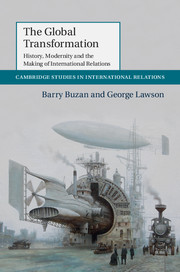Part II - The Making of Modern International Relations
Published online by Cambridge University Press: 05 February 2015
Summary
… of all our contemporary illusions, the most dangerous is the one that underpins and accounts for all the others. And that is the idea that we live in a time without precedent: that what is happening to us is new and irreversible and that the past has nothing to teach us. … Neoclassical economics, liberalism, Marxism (and its Communist stepchild), ‘revolution’, the bourgeoisie and the proletariat, imperialism and ‘industrialism’ – in short the building blocks of the twentieth-century political world – were all nineteenth-century artefacts.
(Judt, 2008: 193)The configuration of global modernity transformed the polities within which it coalesced, and the international systemthat those polities came to dominate. The global transformation fostered radical change both domestically through linking industrialization with state capacity, infrastructural change, technological progress and scientific research, and internationally through coercive interventions in trade, production and financial regimes, and through the acquisition of new territories. This section of the book examines the emergence and institutionalization of the global transformation from the nineteenth century to the present day. The six chapters each take a particular line of development that defines a major theme of contemporary IR, and show: (a) how the basic disjuncture between modernity and what came before took place during the long nineteenth century; (b) what it was that changed, and how; and (c) how these changes impacted on international relations in the twentieth and twenty-first centuries. These six chapters provide the substance behind the book’s two central claims: first, that the nineteenth century can be understood as the opening of a world historical transformation; and second, that this transformation established many of the main features of contemporary international order.
- Type
- Chapter
- Information
- The Global TransformationHistory, Modernity and the Making of International Relations, pp. 65 - 66Publisher: Cambridge University PressPrint publication year: 2015



